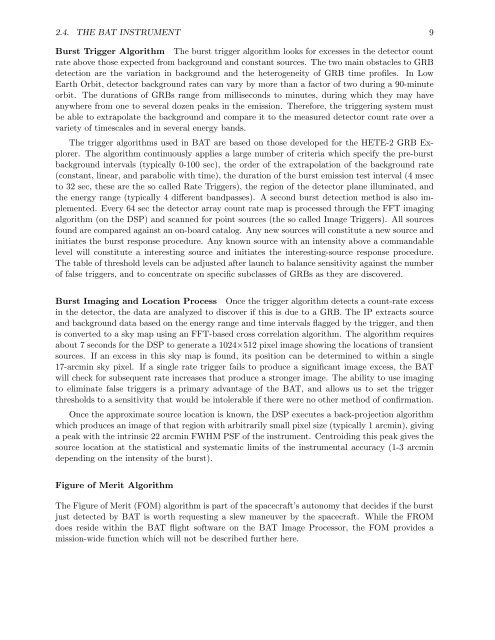The SWIFT BAT Software Guide Version 6.3 30 ... - HEASARC - Nasa
The SWIFT BAT Software Guide Version 6.3 30 ... - HEASARC - Nasa
The SWIFT BAT Software Guide Version 6.3 30 ... - HEASARC - Nasa
Create successful ePaper yourself
Turn your PDF publications into a flip-book with our unique Google optimized e-Paper software.
2.4. THE <strong>BAT</strong> INSTRUMENT 9<br />
Burst Trigger Algorithm <strong>The</strong> burst trigger algorithm looks for excesses in the detector count<br />
rate above those expected from background and constant sources. <strong>The</strong> two main obstacles to GRB<br />
detection are the variation in background and the heterogeneity of GRB time profiles. In Low<br />
Earth Orbit, detector background rates can vary by more than a factor of two during a 90-minute<br />
orbit. <strong>The</strong> durations of GRBs range from milliseconds to minutes, during which they may have<br />
anywhere from one to several dozen peaks in the emission. <strong>The</strong>refore, the triggering system must<br />
be able to extrapolate the background and compare it to the measured detector count rate over a<br />
variety of timescales and in several energy bands.<br />
<strong>The</strong> trigger algorithms used in <strong>BAT</strong> are based on those developed for the HETE-2 GRB Explorer.<br />
<strong>The</strong> algorithm continuously applies a large number of criteria which specify the pre-burst<br />
background intervals (typically 0-100 sec), the order of the extrapolation of the background rate<br />
(constant, linear, and parabolic with time), the duration of the burst emission test interval (4 msec<br />
to 32 sec, these are the so called Rate Triggers), the region of the detector plane illuminated, and<br />
the energy range (typically 4 different bandpasses). A second burst detection method is also implemented.<br />
Every 64 sec the detector array count rate map is processed through the FFT imaging<br />
algorithm (on the DSP) and scanned for point sources (the so called Image Triggers). All sources<br />
found are compared against an on-board catalog. Any new sources will constitute a new source and<br />
initiates the burst response procedure. Any known source with an intensity above a commandable<br />
level will constitute a interesting source and initiates the interesting-source response procedure.<br />
<strong>The</strong> table of threshold levels can be adjusted after launch to balance sensitivity against the number<br />
of false triggers, and to concentrate on specific subclasses of GRBs as they are discovered.<br />
Burst Imaging and Location Process Once the trigger algorithm detects a count-rate excess<br />
in the detector, the data are analyzed to discover if this is due to a GRB. <strong>The</strong> IP extracts source<br />
and background data based on the energy range and time intervals flagged by the trigger, and then<br />
is converted to a sky map using an FFT-based cross correlation algorithm. <strong>The</strong> algorithm requires<br />
about 7 seconds for the DSP to generate a 1024×512 pixel image showing the locations of transient<br />
sources. If an excess in this sky map is found, its position can be determined to within a single<br />
17-arcmin sky pixel. If a single rate trigger fails to produce a significant image excess, the <strong>BAT</strong><br />
will check for subsequent rate increases that produce a stronger image. <strong>The</strong> ability to use imaging<br />
to eliminate false triggers is a primary advantage of the <strong>BAT</strong>, and allows us to set the trigger<br />
thresholds to a sensitivity that would be intolerable if there were no other method of confirmation.<br />
Once the approximate source location is known, the DSP executes a back-projection algorithm<br />
which produces an image of that region with arbitrarily small pixel size (typically 1 arcmin), giving<br />
a peak with the intrinsic 22 arcmin FWHM PSF of the instrument. Centroiding this peak gives the<br />
source location at the statistical and systematic limits of the instrumental accuracy (1-3 arcmin<br />
depending on the intensity of the burst).<br />
Figure of Merit Algorithm<br />
<strong>The</strong> Figure of Merit (FOM) algorithm is part of the spacecraft’s autonomy that decides if the burst<br />
just detected by <strong>BAT</strong> is worth requesting a slew maneuver by the spacecraft. While the FROM<br />
does reside within the <strong>BAT</strong> flight software on the <strong>BAT</strong> Image Processor, the FOM provides a<br />
mission-wide function which will not be described further here.


